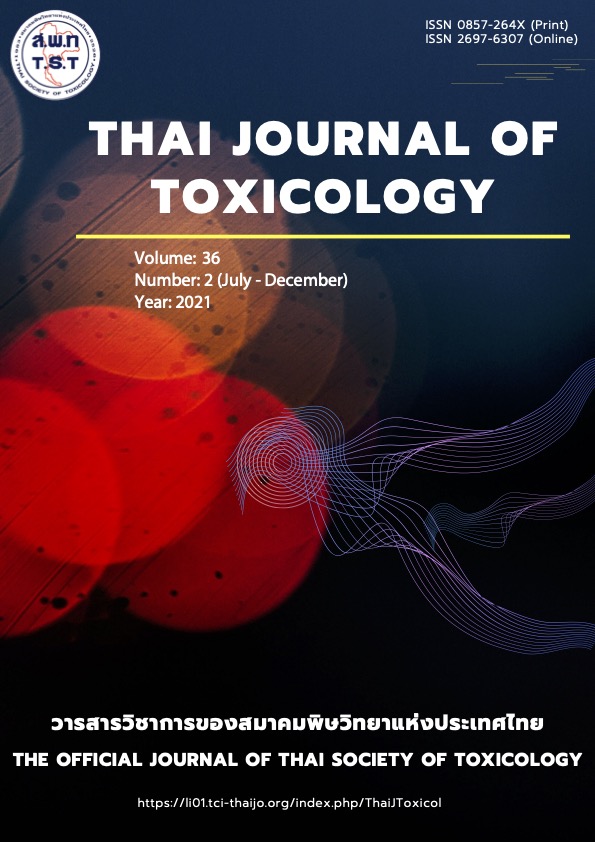Interaction of Phytochemical Components Determine the Protective Effect of Riceberry Rice Bran Extract against Oxidative-Induced Neuronal Cell Death in SK-N-SH Cells
Main Article Content
Abstract
Aging leads to a progressive impairment of mitochondrial function and/or increased oxidative damage has been suggested to play critical roles in the pathogenesis of the neurodegenerative diseases. Brains have a high metabolic rate and relatively low capacity for cellular regeneration, nerve cells in brain area are particularly susceptible damaged by ROS. This study aimed to investigate the effects of Riceberry rice bran extract (RBBE) on H2O2-induced oxidative neuronal toxicity in SK-N-SH cells by measurement of cell viability, intracellular ROS, and mitochondria membrane potential (MPP). Co-treatment results indicated that RBBE and cyanidin acted as pro-oxidants at high level of oxidative stress induced by 400 µM H2O2. Therefore, the pre-treatment method was chosen for this study. High dose H2O2 800 μM resulted in a statistically significant increase in ROS level, and cell death with a decreasing MMP trend. Pretreatment with RRBE at concentration of 5 mg/ml before exposure to H2O2 showed neuroprotective ability by increasing the percentage of cell viability and decreasing the ROS level to the level not different from control. Moreover, the MMP was raised to the level higher than control. However, cyanidin in the dose that contained in 5 mg/ml RBBE did not improved the oxidative neuronal damage. These results might suggest that pre-treatment cells with RBBE attenuated the neuronal cell death resulted from the interaction of mixed phytocemical components in RBBE.
Article Details
References
Dugger NB, Dickson DW. Pathology of neurodegenerative diseases. Cold Spring Harb Perspect Biol 2017; 9: a028035.
Chi H, Chang HY, Sang TK. Neuronal cell death mechanisms in major neurodegenerative Diseases. Int J Mol Sci. 2018; 19: 3082.
Gottlieb E, Armour SM, Harris MH, et al. Mitochondrial membrane potential regulates matrix configuration and cytochrome c release during apoptosis. Cell Death Diff 2003; 1: 709–17.
Albers DS, Beal MF. Mitochondrial dysfunction and oxidative stress in aging and neurodegenerative disease. In: Jellinger K., Schmidt R., Windisch M. (eds) Advances in Dementia Research. Springer, Vienna, 2000: 133-54.
Whittemore ER, Loo DT, Watt JA, et al. A detailed analysis of hydrogen peroxide-induced cell death in primary neuronal culture. Neuroscience 1995; 67: 921–32.
Cai Z, Zhao B, Ratka A. Oxidative stress and β-amyloid protein in Alzheimer’s disease. Neuromol Med 2011; 13: 223–50.
He L, He T, Farrar S, et al. Antioxidants maintain cellular redox homeostasis by elimination of reactive oxygen species. Cell Physiol Biochem 2017; 44: 532-53.
Paiva FF, Vanier, NL, Berrious JDJ, et al. Physicochemical and nutritional properties of pigmented rice subjected to different degrees of milling. J Food Chemp Anal 2014; 35: 10-17.
Tan J, Li Y, Hou DX, et al. The effects and mechanisms of cyanidin-3-glucoside and its phenolic metabolites in maintaining intestinal integrity. Antioxidants 2019; 479: 1-16.
Pannangrong W, Wattanathorn J, Muchimapura S, et al. Purple riceberry is neuroprotective and enhances dognition in a rat model of alzheimer’s disease. J Med Food 2011; 14: 688-94.
Blokhina O, Virolainen E, Fagerstedt KV. Antioxidants, oxidative damage and oxygen deprivation stress: a review. Ann Bot 2003; 91: 179–94.
Akagawa M, Shigemitsu T, Suyama K. Production of hydrogen peroxide by polyphenols and polyphenol-rich beverages under quasi-physiological conditions. Biosci Biotechnol Biochem 2003; 67: 2632–40.
Eghbaliferiz S, Iranshah M, Prooxidant activity of polyphenols, flavonoids, anthocyanins and carotenoids: updated review of mechanisms and catalyzing metals. Phytother Res 2016; 30: 1379–91.
Kühlbrandt W. Structure and function of mitochondrial membrane protein complexes, BioMed Central 2015; 13: 1-11.
Satoh T, Enokido Y, Aoshima H, et al. Changes in mitochondrial membrane potential during oxidative stress‐induced apoptosis in PC12 cells. J Neurosci Res 1997; 50: 413-20.
Tan JL, Li QX, Ciccotosto GD, et al. Mild oxidative stress induces redistribution of BACE1 in non-apoptotic conditions and promotes the amyloidogenic processing of Alzheimer’s disease amyloid precursor protein, PLoS ONE 2013; 8: 1-14.
Chan ED, Riches DWH, White CW. Redox paradox: effect of N-acetylcysteine and serum on oxidation reduction–sensitive mitogen-activated protein kinase signaling pathways. Am J Respir Cell Mol Biol 2001; 24: 627–32.
Charles I, Khalyfa A, Kumar DM, et al. Serum deprivation induces apoptotic cell death of transformed rat retinal ganglion cells via mitochondrial signaling pathways. IOVS 2005; 46: 1330-38.
Caesar LK, Cech NB. Synergy and antagonism in natural product extracts: when 1 + 1 does not equal 2. Nat Prod Rep 2019; 36: 869–88.


